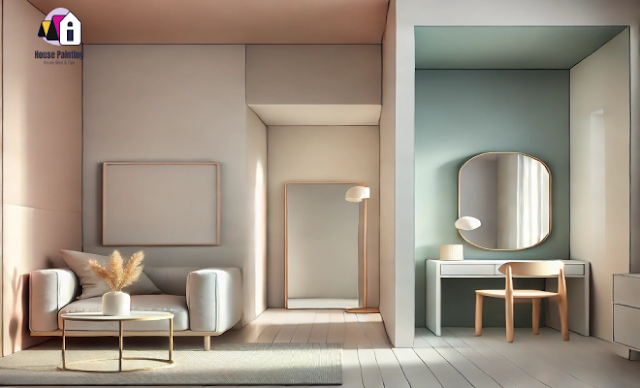Small spaces can feel cozy and inviting, but they can also appear cramped if not designed thoughtfully. The right paint colors and techniques can transform these spaces, making them appear larger, brighter, and more harmonious. Here’s how to use paint to improve small spaces and create the illusion of openness and light.
1. Light and Neutral Colors for Spaciousness
Light and neutral colors are the go-to choice for enhancing small spaces. They reflect natural light, making the room feel airy and expansive.
- Soft Whites and Off-Whites: These shades make walls recede visually, creating a sense of openness.
- Pastels: Light pastel shades like pale blue, lavender, or mint add subtle color without overwhelming the room.
- Neutral Grays and Beiges: These timeless hues provide warmth and versatility, complementing various decor styles.
2. Create Depth with Accent Walls
An accent wall can add depth and character to a small room without making it feel cluttered.
- Use Darker Shades Strategically: Painting one wall in a darker color, such as navy or deep green, can create the illusion of depth.
- Texture and Patterns: Subtle textures or geometric patterns can add visual interest without overwhelming the space.
3. Use Vertical Stripes for Height Illusion
Vertical stripes painted on walls or used in wallpapers can draw the eye upward, making ceilings appear higher.
- Choose Contrasting Colors: Alternate between two light shades for a balanced and elegant look.
- Thin Stripes for Subtle Effects: Thin stripes are less overpowering and create a refined aesthetic.
4. Reflective and Glossy Finishes
Paint with reflective or glossy finishes can help bounce light around the room, creating a more open feel.
- High-Gloss Paint for Ceilings: A glossy ceiling finish reflects light downward, adding brightness.
- Semi-Gloss Walls: Use semi-gloss on walls to achieve a subtle reflective effect without excessive shine.
5. Highlight Trim and Moldings
Painting trims and moldings in a lighter color than the walls can make the room appear more spacious.
- Contrasting Colors: Pair darker walls with bright white trim to frame the space and add visual contrast.
- Cohesive Palette: Use a cohesive color palette for trim and walls to create a seamless and unified look.
6. Monochromatic Schemes for Simplicity
Using a single color throughout the space creates continuity, making it feel larger.
- Tone-on-Tone Variations: Experiment with different shades of the same color for walls, furniture, and decor.
- Minimalist Aesthetic: Monochromatic schemes lend themselves well to minimalist designs, reducing visual clutter.
7. Light Ceilings for Expansiveness
A lighter ceiling color draws the eye upward and makes the space feel taller.
- Classic White Ceilings: White ceilings are a classic choice to enhance height perception.
- Soft Contrasts: Pair a slightly darker wall color with a white or pastel ceiling for balance.
8. Add Personality with Subtle Patterns
While bold patterns can overwhelm small spaces, subtle designs can add personality and depth.
- Stencils and Stripes: Use stencils to create simple patterns, like chevrons or polka dots, for a playful yet understated effect.
- Gradient Walls: Ombre effects, blending light to dark shades, can make a small room feel dynamic and modern.
9. Reflect Light with Mirrored Accents
Paint isn’t the only tool for improving small spaces; pairing it with mirrors amplifies its effect.
- Mirror Frames and Panels: Paint frames in colors that match the walls for a cohesive and space-enhancing look.
- Position Mirrors Opposite Windows: Maximize natural light by reflecting it across the room.
10. Avoid Overwhelming Contrasts
While contrasts can be appealing, excessive variations in color can make small rooms feel fragmented.
- Stick to a Palette: Use two to three harmonious colors throughout the room.
- Soft Transitions: Gradual transitions between shades maintain a sense of flow.
Practical Tips for Painting Small Spaces
- Test Colors: Use paint samples to observe how colors look in different lighting.
- Prep Your Walls: Smooth, clean surfaces enhance the appearance of your chosen paint.
- Keep It Simple: Avoid overdecorating, which can counteract the effects of your paint choices.
Final Thoughts
With the right paint choices and techniques, small spaces can feel more open, welcoming, and stylish. By focusing on light colors, reflective finishes, and strategic accents, you can transform your compact rooms into vibrant, functional spaces. Let your creativity shine and enjoy the impact of paint in redefining your home.

